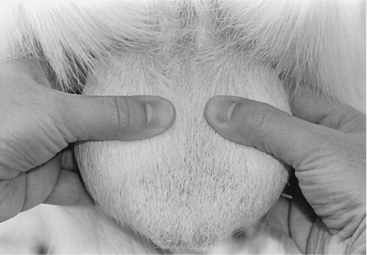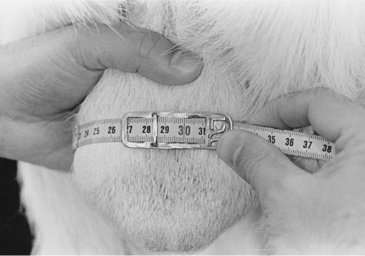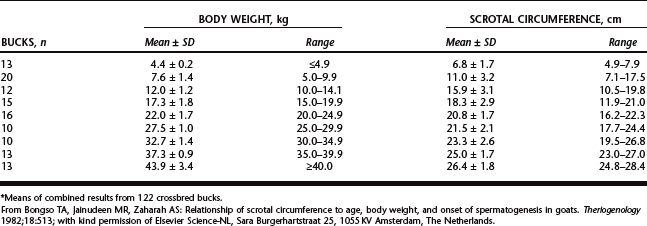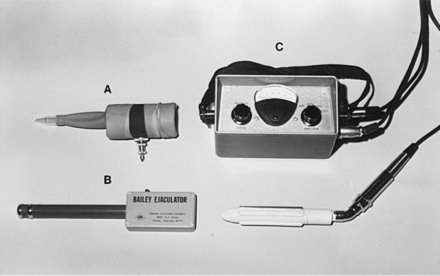CHAPTER 65 Examination of the Reproductive Tract and Evaluation of Potential Breeding Soundness in the Buck
EXAMINATION OF THE REPRODUCTIVE TRACT
The testes should be examined for size, symmetry, and consistency (Fig. 65-1). Seasonal variations and breed differences must be kept in mind. A sound buck during the breeding season should have large oval testes that are firm to the touch and of equal size. Soft, nonresilient testes are usually seen during the nonbreeding season or may be associated with poor health. Scrotal thermography and ultrasonography are techniques that may be useful in aiding detection or confirmation of abnormalities of the scrotum and its contents. These recently developed diagnostic methods are not yet economical or practical in field situations. The epididymis consists of three anatomic parts: the head, the body, and the tail. Attention should be given to alterations in their size, form, and consistency. Gross alterations in the epididymis are fairly rare in the goat.
The penis should be extended and examined. This is usually accomplished while collecting a semen sample when an electroejaculator is used. Otherwise, the penis must be manually extended from the sheath so that a careful examination can be made. The urethra extends beyond the tip of the penis about 2 to 3 cm, forming the urethral process. The urethral process is thought to aid in spraying semen around the os of the cervix. When bucks have urinary calculi, the urethral process is the common area of obstruction. The urethral process is usually removed during treatment of urolithiasis with no apparent detrimental effect on fertility.1
SCROTAL CIRCUMFERENCE AND ITS CORRELATION WITH SPERM PRODUCTION
Scrotal circumference measurements, because of their high correlation with testicular size and capacity for sperm production, have become an integral part of the breeding soundness evaluation of bulls. Information on similar relationships is limited in bucks, however. Using a nonstretchable tape, the examiner measures the scrotum at the point of its greatest diameter, pulling the tape snugly and applying moderate tension so that the testes are pulled together and the tape is in contact with the entire circumference (Fig. 65-2). There is a positive correlation between scrotal circumference and body weight in bucks (Table 65-1).2 Based on data collected in young growing and mature Nubian bucks, the mean scrotal circumference measurements at 5, 8, 21, and 36 months of age are 14, 20, 26, and 30 cm, respectively. In mature bucks, scrotal circumference is positively (P < 0.01) correlated with both sperm concentration per milliliter and total sperm per ejaculate, but the correlation is significantly higher in the latter (r, 0.66 versus 0.36).3
LIBIDO
Libido is an essential component of breeding performance but is difficult to measure during a routine breeding soundness examination. When semen samples are collected with an artificial vagina, libido can be assessed to some degree. A carefully obtained history may reveal whether does are being covered and whether intromission and ejaculation (indicated by a sudden backward motion of the head) occur.
SEMEN COLLECTION
Semen can be satisfactorily collected from bucks using an artificial vagina (AV), an electroejaculator, or a Bailey ejaculator* (Fig. 65-3). The AV consists of the following parts: (1) a rubber tube that is 8 inches long and 2 inches in diameter and is equipped with an air and water valve, (2) a rubber pressure bulb, (3) a latex inner liner, (4) a latex semen collection funnel, (5) two wide rubber bands, (6) a 15-ml graduated Pyrex collection vial, and (7) a nondrying, nonspermicidal lubricant.† No exogenous stimulus is needed when semen is collected with an AV; however, the buck must be trained to serve the AV using a mount animal. A doe in estrus is an ideal mount animal; however, a doe in diestrus injected intramuscularly with 5 to 10 mg prostaglandin F2 alpha,* or an ovariectomized doe injected intramuscularly on alternate days with 1 mg of estradiol cypionate† could be used as a mount animal.4 The casing of the AV is filled with warm water to provide an internal temperature of approximately 39° C at the time of collection. Air is added to create pressure and the AV is lubricated immediately before collection. After two false mounts, the buck is allowed to serve the AV. The penis is never handled directly, but is directed by grasping the sheath or the prepuce. The buck will seek the AV, then thrust into it. The AV should never be slipped onto the penis.
Stay updated, free articles. Join our Telegram channel

Full access? Get Clinical Tree






